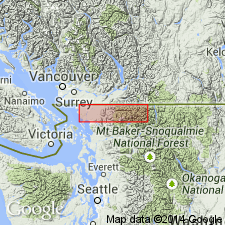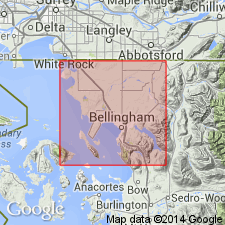
- Usage in publication:
-
- Kulshan glaciomarine drift
- Modifications:
-
- Original reference
- Dominant lithology:
-
- Drift
- AAPG geologic province:
-
- Bellingham basin
Summary:
Pg. 1469 (table 1), 1472-1475, pl. 3. Kulshan glaciomarine drift. Consists of massive blue-gray unsorted and unstratified till-like sediments. Coarser fraction consists of pebbles, cobbles, and few boulders. Younger than Vashon drift. Underlies Deming sand (new) along Nooksack River near Cedarville. Age is late Pleistocene, based on radiocarbon age of 11,640 +/-275 yr B.P.
Occurs in northern Puget Lowland, northwestern WA. Covered by younger deposits over most of Puget lowland; crops out near beach level at sea cliffs along Bellingham Bay.
Source: US geologic names lexicon (USGS Bull. 1350, p. 405-406); GNU records (USGS DDS-6; Menlo GNULEX).

- Usage in publication:
-
- Kulshan Drift*
- Modifications:
-
- Adopted
- Mapped
- Geochronologic dating
- AAPG geologic province:
-
- Puget Sound province
Summary:
Named by Easterbrook (1963) for exposures along nooksack River, 1.25 mi southeast of Cedarville sec.34 T35N R4E [western Whatcom Co, WA]. [no type designated] Consists of blue-gray, unsorted and unstratified mixture of silt, clay, and pebbles. Till-like deposit, not highly compacted, composed of debris melted out of floating glacier ice and deposited on sea floor when sea level was at least 300 ft higher than at present. Marine shells dated by radiocarbon between 12,900 and 11,600 yr B.P. Thickness generally 15 to 25 ft. Is part of Everson Interstade of Frasier Glaciation. Is Pleistocene age.
Source: GNU records (USGS DDS-6; Menlo GNULEX).
For more information, please contact Nancy Stamm, Geologic Names Committee Secretary.
Asterisk (*) indicates published by U.S. Geological Survey authors.
"No current usage" (†) implies that a name has been abandoned or has fallen into disuse. Former usage and, if known, replacement name given in parentheses ( ).
Slash (/) indicates name conflicts with nomenclatural guidelines (CSN, 1933; ACSN, 1961, 1970; NACSN, 1983, 2005, 2021). May be explained within brackets ([ ]).

